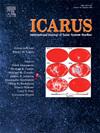Impacts of mesoscale meteorology on the evolution of fluvial features in Lyot crater, Mars
IF 2.5
2区 物理与天体物理
Q2 ASTRONOMY & ASTROPHYSICS
引用次数: 0
Abstract
Identifying possible fluvial activity during the past and near present on Mars is a key area of martian research, as the occurrence of stable surface water can be an indicator of potentially habitable locations which are of astrobiological interest. Lyot crater is an early Amazonian-aged impact crater in the northern lowlands of Mars. It has a microenvironment due to the low elevation of its interior, where fluvial features and ice-rich landforms have been identified today. We modelled the mesoscale atmospheric conditions in Lyot over the past 20 million years, as Mars’s orbital parameters changed, to identify periods in time and space where conditions were suitable for stable surface water. As well as investigating surface temperature and pressure, an assessment was also made of the impact of relative humidity and evaporation on stable surface water, and the effect of solar insolation and shadowing on the longevity of ice-rich meltwater source materials. At lower obliquities the modelled atmospheric states identify conditions when stable surface water could flow in the summer over much of the crater for a few hours per sol. At higher obliquities modelled conditions suitable for stable water were restricted to the lowest elevation areas of the crater interior. These are areas where the longest channels have been identified and are also areas where standing bodies of water may have formed as these long channels drained into topographic lows. The conditions suitable for supporting stable liquid water at the surface only occurred in the model for short periods of time, hence, an assessment was also made as to the possible behaviour of surface water during the longer intervals when conditions were not suitable. During these times surface water would have boiled or frozen, although if the depth of surface water was sufficiently deep, then a layer of ice on the surface of the water could have protected the liquid water underneath. It would then flow again when conditions were suitable and the ice cover melted or if conditions remained unsuitable the covered water feature would stagnate and disappear over time. This research supports the conclusion drawn from geomorphological analysis that stable surface water occurred in specific locations such as Lyot crater in the recent past on Mars.
中尺度气象对火星Lyot陨石坑河流特征演化的影响
确定过去和近期火星上可能的河流活动是火星研究的一个关键领域,因为稳定地表水的出现可以作为潜在可居住地点的一个指标,这是天体生物学感兴趣的。Lyot陨石坑是位于火星北部低地的一个早期亚马逊时代的陨石坑。由于其内部海拔较低,它具有微环境,今天已经确定了河流特征和富含冰的地貌。随着火星轨道参数的变化,我们模拟了过去2000万年里Lyot的中尺度大气条件,以确定适合稳定地表水的时间和空间时期。除了调查地表温度和压力外,还评估了相对湿度和蒸发对稳定地表水的影响,以及太阳日照和阴影对富冰融水源物质寿命的影响。在较低的倾角下,模拟的大气状态确定了夏季稳定的地表水可以在陨石坑的大部分地区流动几个小时的条件。在较高的倾角下,适合稳定水的模拟条件仅限于陨石坑内部的最低海拔区域。在这些地区,人们发现了最长的河道,在这些地区,随着这些长河道流入地势较低的地方,可能形成了静止的水体。适合地表稳定液态水存在的条件只在模型中出现了较短的时间,因此,在条件不合适的较长时间间隔内,也对地表水的可能行为进行了评估。在这段时间里,地表水会沸腾或冻结,尽管如果地表水的深度足够深,那么水面上的一层冰可能会保护下面的液态水。当条件合适,冰盖融化时,它会再次流动,或者如果条件仍然不合适,覆盖的水特征会随着时间的推移而停滞和消失。这项研究支持了地貌学分析得出的结论,即在最近的火星上,在Lyot陨石坑等特定地点出现了稳定的地表水。
本文章由计算机程序翻译,如有差异,请以英文原文为准。
求助全文
约1分钟内获得全文
求助全文
来源期刊

Icarus
地学天文-天文与天体物理
CiteScore
6.30
自引率
18.80%
发文量
356
审稿时长
2-4 weeks
期刊介绍:
Icarus is devoted to the publication of original contributions in the field of Solar System studies. Manuscripts reporting the results of new research - observational, experimental, or theoretical - concerning the astronomy, geology, meteorology, physics, chemistry, biology, and other scientific aspects of our Solar System or extrasolar systems are welcome. The journal generally does not publish papers devoted exclusively to the Sun, the Earth, celestial mechanics, meteoritics, or astrophysics. Icarus does not publish papers that provide "improved" versions of Bode''s law, or other numerical relations, without a sound physical basis. Icarus does not publish meeting announcements or general notices. Reviews, historical papers, and manuscripts describing spacecraft instrumentation may be considered, but only with prior approval of the editor. An entire issue of the journal is occasionally devoted to a single subject, usually arising from a conference on the same topic. The language of publication is English. American or British usage is accepted, but not a mixture of these.
 求助内容:
求助内容: 应助结果提醒方式:
应助结果提醒方式:


